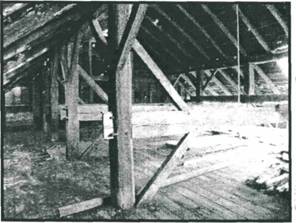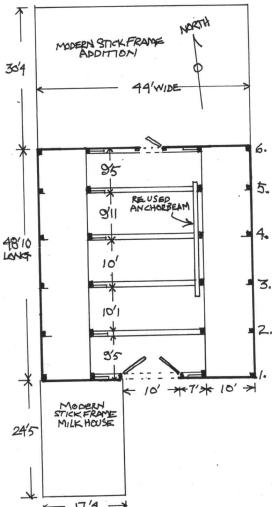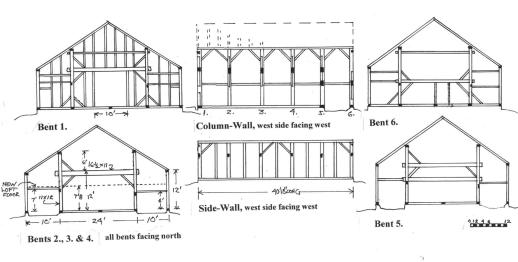HVVA
NEWSLETTER, January 2006
(Click
on graphics/photos for larger view)
HVVA Newsletters
FROM
THE JOURNAL
Wednesday, December 28 Responding to an E-mail from Karlyn Elia,
Ulster County Historian, I went to see a Dutch barn on Route 32 in
Saxonville, Saugerties, an area on the north border of Ulster County
with Greene. It was registered some years ago as (__/Kocis Uls/Sau/012)
but never measured.
| 5-Bay
Dutch U-Barn with additions _/Kocis (NY/Uls/Sau/012) Saxton,
Saugerties, Ulster County, NY N42'09.105; W047'00.007; 422'
elevation |
Joe
Kocis and his son Steve are working together to repair the barn.
Some of the side-wall and aisle rafters have already
been restored. They are working toward replacing the roof.
already
been restored. They are working toward replacing the roof.
The barn is unusual in several ways. It seems to be a square-rule
frame, normally dating it after 1810 but the barn has features that
are earlier, especially the extended and wedged tenons of the anchorbeams.
There are also 2-foot level scribe marks on two of the anchorbeams.
These are traditional scribe-rule markings indicating the carpenters
knew some of the old lay-out tradition. The frame is made of hardwood,
perhaps a mix of oak and chestnut.
| Loft of 5-Bay
Kocis Dutch Barn, facing north Saugerties, Ulster County, NY |
It
seems that there were four-part wagon doors with strap hinges only
on the south front facing the present house. These doors swung
into the barn like the earlier wooden hinged and harr hung doors
did. There are reused anchorbeams from an early barn with lap-dovetail
joining of the braces and a longitudinal-strut reused as a stud
in the north end wall. It has notches for a horse hay-rack but
there is no evidence of nails holding the bars of the rack, perhaps
they were tied on?
Another
unusual feature of the barn frame are the upper braces on the four
internal anchorbeams but only on the side toward the mountains
and away from the road. There are very serious winds in this area
and the braces seem designed to resist that force. The tails of
the rafters on this side are nailed with short boards to the plate
so that the wind will not have a place to get under the roof and
blow it off.
 Wednesday,
January 4 I
met with Tom Colucci at the Kocis Dutch Barn in Saxton. We spent
an hour or two going over the barn and made a number of observations
that I had missed. I had come back to look for evidence of a lowered
anchorbeam in bent 5.. I found that and a more complete drawing
of the end walls and their very unique bracing, also more intriguing
carpenter's scribe markings. The one-foot difference in the height
of the aisle struts indicAtes cow and horse aisles.
Wednesday,
January 4 I
met with Tom Colucci at the Kocis Dutch Barn in Saxton. We spent
an hour or two going over the barn and made a number of observations
that I had missed. I had come back to look for evidence of a lowered
anchorbeam in bent 5.. I found that and a more complete drawing
of the end walls and their very unique bracing, also more intriguing
carpenter's scribe markings. The one-foot difference in the height
of the aisle struts indicAtes cow and horse aisles.
When
the barn was converted to a dairy operation, perhaps 100-years
ago, a lowered ceiling was installed at the height of the lowered
anchor beams and all four internal columns on the road side were
cut off at this 7'8" floor level and the bottoms of the wood
columns replaced with metal supports, a common conversion.
In order to have a wide, 20'
side entrance into the nave at bent 4., the right column was cut off
at the anchorbeam, that was then supported from above by a metal strap
tied to a circa 24-foot long part of an early circa 30-foot long re-used
oak anchorbeam, resting on the new anchorbeams 3. and 5..
Thursday,
December 29 I
drove with Jim Decker to the Town of Ghent, in northern Columbia County.
We met up with Alvin Shaffer and George Yonnone, a restoration craftsman
from West Stockbridge, Massachusetts. George had wanted us to see
a two story ramp barn that the owners would consider selling for removal,
if they felt that the buyer was interested in reconstructing it and
not using it for lumber and parts. It is a complex frame using parts
of at least one scribe-rule Dutch barn. There are at present two reused
25-foot long pine anchorbeams on the two internal bents set about
7.5-feet from the floor. They measure 12X 19 inches.

Floor Plan, Bents, Column Wall and Side
Wall
The Kocis 5-Bay Dutch U-barn, Saxton, Saugerties, Ulster
County, NY
The south end-wall, Bent 1., is shown with studs and two conjectured
animal door openings on the sides.
The internal bents 1., 2. and 3. are classic Dutch bents except for
the one upper brace on the anchorbeam.
The north end-wall, Bent 6., is shown without studs and a conjectured
door opening.
The double anchorbeams in Bent 5. maintains the 12-foot level and
supports the lowered 7-foot mow.
The West Column-Wall shows a conjectured dirt floor for animals in
the back-bay between Bents 5. and 6..
The West Side-Wall shows a very regular placement of posts and studs.
This is also true of the placement of the 16-
pairs of rafters. It is a feature that may indicate age or ethnicity.
The
beams have no evidence of braces so it was conclude that they had
been shortened from original 30-foot
long beams and that the present side wall posts were the original
columns with anchorbeams set 13' from the floor and a 7 or 8-foot
verdiepingh. It was a large Dutch barn.
30-foot
long beams and that the present side wall posts were the original
columns with anchorbeams set 13' from the floor and a 7 or 8-foot
verdiepingh. It was a large Dutch barn.
It is an interesting barn frame and with some imagination it could
be made into a nice house. It is also a kind of reconstructed frame
with reused parts in which, with more time and study, someone could
help deduce the area's 18 century Dutch barn tradition, so little
of which has survived.
George
took us to two nearby barns he is working on. The first was an
English three-bay barn in New Concord (the name attests to the
English invasion into Yorker territory). The scribe-rule late
18 century frame has Dutch H-bents and raising
holes, but English use of the anchorbeams as summer beams with joists
and the rafters having tails overhanging the plate They seem to be
a modified English step-lap. The siding of the barn was originally
vertical like New England barns but later sided with horizontal weatherboards.
George pointed out that the braces were irregular in their measurements
indicating they were laid out with scribe rule Braces in Dutch barns
were standardized long before square rule was adopted for the main
I woud guess that the original carpenters
spoke English and used English framing traditions but had adopted
the H-bent and raising hole of the Dutch. (*)
Finally
we went to a 4-bay side entrance barn in Claverack. It is an English
barn plan with side entrances and center threshing floor. The frame was
designed for a mid to late 19th century American hay barn with sawn,
rather than hewn timbers. Its bents have vertical queen posts supporting
purlins and held back with metal ties. It seems to have been designed
for a metal hay-track, used to unload loose hay from the wagons. It was
once a Lown farm, a prominent family of this area. Alvin says the Lown
gang played a big part in the violent boarder wars of the 18th century,
disputes over the boundary claims of Massachusetts and New York. It is
a very hilly part of Columbia County that still retains a feeling of
an isolated borderland; the early roads that once connected the Hudson
Valley with Boston, now see little traffic.
(*) Greg
Huber, editor of the 2™ edition of The New
World Dutch Barn, disagrees with my labeling the Stewart barn
in Red Hook (RH/012) as a Dutch barn, it is similar to the New
Concord barn, see HWA Vol. 7. No. 8. We did not measure or spend
much time with the Stewart barn but my impression was that it had
an English 3-bay side-entrance plan but a Dutch frame. I would
guess that the carpenters spoke a Dutch/German dialect and were
familiar with an early Dutch rafter design. Greg objects to my
calling this a major/minor rafter system because it does not have
a ridge pole. There
are probably only three or four examples of this rafter system known
in America and they all have design differences. These are rare survivals
of 17th and 18th century Dutch techniques.
Carpenters with New England framing
traditions did work in Red Hook. Bob Hedges knows of a barn in ruins
near the Steward barn that has flared posts. We hope to visit that in
spring. Todd Scheff put me on to the two-story brick Wagner House in
Upper Red Hook (RH/21) that originally had a gambrel roof with English
framing. From reading Walter Wheelers recent article on gambrel roofs,
I would guess it was built by Boston carpenters.
Sometime
in April or May when the Vogels return from Florida, we plan to continue
the Red Hook Survey and to revisit the Stewart barn with new eyes and
do a better documentation. If you would like to join us send a
note. Greg writes that he knows of some Dutch barns in southwestern
Vermont. Would he let us know their location for our Dutch Cultural
Resources Survey?
